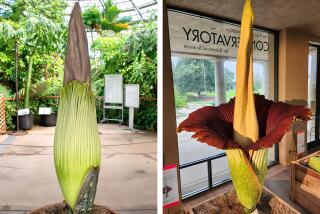Li’l Stinker didn’t bloom as expected. But you can still experience the reek of corpse flower at the Huntington
For weeks, fans of the notoriously reeking corpse flower, or Amorphophallus titanum, eagerly anticipated the blooming of 15-year-old Li’l Stinker at the Huntington Library, Art Collections, and Botanical Gardens.
Unfortunately, Li’l Stinker failed to bloom last week as expected, perhaps to save energy for a future attempt, said Brandon Tam, an orchid collection specialist working with the Huntington’s 44 corpse flowers.
But followers of the smelly gargantuan plant should not fret — a sibling of Li’l Stinker, named simply Stink, caught observers off guard on Thursday when it unexpectedly blossomed.
“This was a tremendous surprise,” Tam said. “Truly, these plants have a mind of their own.”
The blooms are rare and unpredictable, usually occurring every five to 10 years. The last time Huntington saw a bloom was in 2014.
Visitors can see the flower in all its glory until 5 p.m. Friday. It will likely wilt throughout Saturday — but Stank and Stunk, two other siblings of Stink, are expected to bloom soon so the public will have yet another opportunity to witness the rare botanical event. Tam said he expects the two plants to bloom in about a week, maybe within a few days of each other.
“We call them the Titan Triplets because we’ve never had three that will bloom at the same time,” he said. “It’s impressive, because as far as I know there’s not many institutions that have the space to have 44 of these mature, blooming size plants.”
The Huntington was the first California institution to bloom the flower in 1999 and has since bloomed five more. With so many mature corpse flowers, they’re expecting a lot more blooms in the coming years, Tam said.
The corpse flower’s scientific name means “giant, misshapen phallus.” Its central column, the spadix, can grow to be more than 6 feet tall and is surrounded by a scarlet skirt of petals known as the spathe. When the spathe unfurls, the chartreuse spadix heats up to about 90 degrees and releases a rancid blend of chemicals.
In its natural environment — rain forests in Indonesia’s Sumatra island — the plant’s scent mimics decomposing carrion that attracts pollinators such as dung beetles, sweat bees and flesh flies, which crawl into the flower and get covered in its pollen. When the insects find no meat, they fly away and spread the pollen.
Stink didn’t get the same hype in anticipation of its bloom as Li’l Stinker, who had a countdown on the library’s Instagram page (and, when it decided not to bloom, a dissection broadcast live on Facebook.)
“This one we didn’t broadcast as much because we felt we had the public so invested in Li’l Stinker that we didn’t want to break their hearts twice,” Tam said.
The plants are one of the Huntington’s biggest attractions, drawing thousands and an immense social media response. Members visit the gardens daily to check on them and some visit to check it off their “list of things to do before they die.”
“To be able to successfully grow it and bloom it is a once in a lifetime opportunity,” Tam said. “These plants are like our kids. We spend so much time with them that we feel we have this personal attachment to them.”
Times staff writer Laura Newberry contributed to this story.
More to Read
Sign up for Essential California
The most important California stories and recommendations in your inbox every morning.
You may occasionally receive promotional content from the Los Angeles Times.











